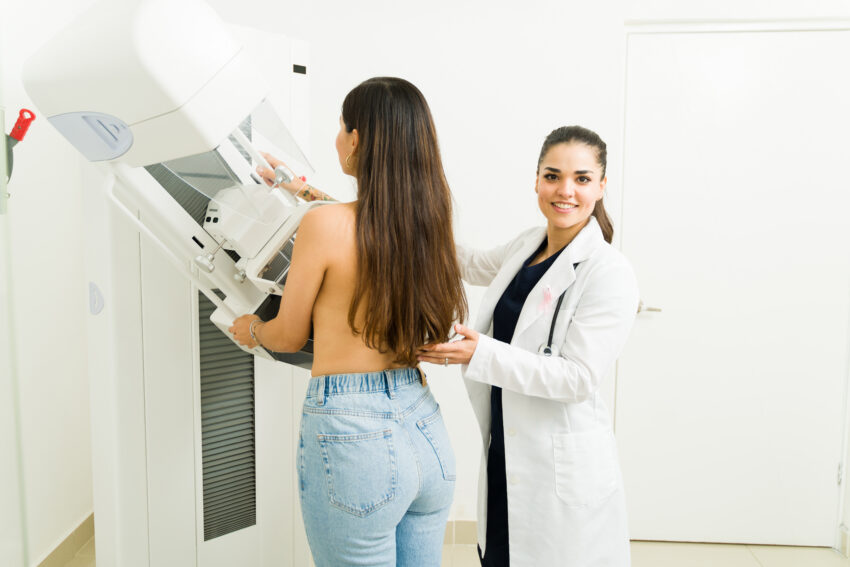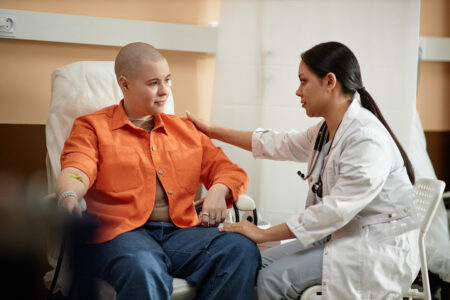
Share On Social!
Every year, 240,000 women are diagnosed with breast cancer in the US, according to the Centers for Disease Control and Prevention (CDC).
That’s why healthcare providers recommend women ages 50 to 74 get a mammogram – an X-ray of the breast that can help screen and diagnose cancer – every two years.
However, only about 3 in 4 women in that age group has had a mammogram in the past two years, as of 2022, according to a new study by the CDC.
For women who experience health-related social needs, even fewer haven’t gotten one.
This is alarming because, while mammograms can reduce the number of breast cancer deaths by 22%, this cancer is the top cause of death among Latinas.
Let’s explore the social determinants of health (SDoH) that are creating barriers to life-saving breast cancer screenings and how we can address these inequities.
Barriers to Breast Cancer Screenings
Mammogram use in women ages 50 to 74 ranged from 64% to 85.5%, according to the CDC study results.
Those who had a mammogram within the last two years tended to have health insurance and a personal care provider.
Women who said they weren’t affected by SDoH or health-related social needs – the non-medical factors that impact health, such as access to healthy food and reliable transportation – had a mammogram prevenance of 83.2%.
However, women who experienced three or more SDoH issues had a prevalence of 65.7%.
Many respondents cited life dissatisfaction, feeling socially isolated, experiencing lost or reduced hours of employment, receiving food stamps, lacking reliable transportation, and cost as barriers to not receiving a mammogram within the last two years.
Cost continues to be one of the largest barriers to cancer care and prevention.
An estimated 28 million people were uninsured at some point in 2022 — many of them Latinos and other people of color, according to the National Health Interview Survey.
In 2021, Latinos were among the highest uninsured populations at 34% followed by Native Hawaiian or other Pacific Islander at 31%, American Indian or Alaska Native at 29%, and Black Americans at 19%.
Healthcare costs can surge even higher for those who need preventive screenings the most, such as individuals with a history of cancer.
For example, Latinos with a history of cancer pay more than double the cost for treatment than Latinos without a history of cancer, according to the American Cancer Society.
Latino cancer survivors ages 18 to 64 spent $9,119 a year on healthcare versus the $3,319 a year Latinos with no history of cancer spent between 2018 and 2019.
Cancer survivors who are Latino and older than 65 spent an average of $22,729 a year, while Latino seniors without a history of cancer spent $10,684.
Respondents were also asked about their experiences with food insecurity, paying bills, and stress levels — all of which can affect someone’s ability to receive a routine cancer screening.
Latinas and Breast Cancer
Despite suffering some of the highest rates of cancer, Latinos have some of the lowest cancer screening rates compared to their peers, resulting in cancer detection at later, harder-to-treat stages and worse cancer outcomes.
While Latinas have a lower risk for developing breast cancer — 28% less than white women — breast cancer is still a critical issue for this population.
For example, Latinas also are being diagnosed at younger ages and with more advanced stages of the disease, resulting in them being 30% more likely to die from breast cancer than non-Latinas, according to the Breast Cancer Research Foundation.

The rate of breast cancer incidence in Latinas between 2016 and 2020 was 100.7, compared with 134.9 white, 129.6 Black, 115.5 American Indian/Alaskan Native, and 104.6 Asian American/Pacific Islander, according to the American Cancer Society’s Cancer Facts & Figures 2024 report.
Despite the relatively low rate in comparison to other ethnicities, Latinas experienced breast cancer death at a rate of 13.7, compared to 19.7 white, 27.8 Black, 21.1 American Indian/Alaskan Native, and 11.8 Asian American/Pacific Islander.
The higher rates of death can be attributed to the lack of breast cancer screenings, leading to a delay in diagnosis and treatment.
Latinas are less likely to get screening for mutations, have more infrequent mammograms, and sometimes don’t follow-up on abnormal results, according to BCRF.
Reasons why this happens include limited access to care, health insurance coverage, and language barriers, among other things.
Other risk factors such as poor diet and lack of physical activity, culminating in conditions like obesity in diabetes, may also play a role in the diagnosis.
78.8% of Latinas are overweight or obese, compared to 64% of white women, and Latinas are 20% more likely to be overweight compared to white women, according to the US Department of Health and Human Services Office of Minority Health.
Increasing Cancer Screening and Prevention
By understanding some of the factors driving the lack of cancer prevention in Latinos and other marginalized groups, we can target these inequities at the source.
Raising cancer screening awareness is one way to reach impacted communities.
A National Cancer Institute study suggests that targeted messaging via text and mail may increasing cancer screening. Another NCI study showed success sending out postcard primers, mailed FIT screening kits, and follow-up phone calls with bilingual staff and patient navigators.
Other methods to increase cancer prevention were made via a study led by the American Cancer Society, Iowa Get Screened, Iowa Cancer Consortium, and Upper Midwest Public Health Training Center.
The study pinpointed four elements for successfully improving cancer screening rates, : making recommendations, developing a screening policy, being persistent with reminders, and measuring practice progress.
Lastly, to improve cancer prevention, we must share important resources.
Campaigns like Early Detection = Better Outcomes provides resources such as screenings you need at every age, tools to find free and low-cost cancer screenings, and information on how your family health history can impact your cancer risk.
The campaign helps you develop a personalized screening plan you can take with you to the doctor’s office, provides tips and information on insurance coverage, and has helpful tools and information available in Spanish.
The campaign initiated by the Prevent Cancer Foundation’s resource hub also has more resources, including a screening quiz and guide to preventing cancer.
“When we work together, we can make significant progress in reducing the cancer death rate by at least half, preventing more than four million cancer deaths by 2047, and improving the experience of people touched by cancer, as envisioned by the Cancer Moonshot,” according to the Prevent Cancer Foundation.
Lack of Diversity in Clinical Research
Another reason Latinas tend have higher rates of death due to breast cancer is the limited amount of research for people of color.
Only about one out of every five (21.9%) people with cancer enroll in clinical research, according to a study in the Journal of Clinical Oncology led by the American Cancer Society Cancer Action Network, Fred Hutchinson Cancer Center, and others.
Latinos make up only a small percentage of those who do choose to enroll in clinical research.
As of 2019, Latinos made up 10% of National Cancer Institute clinical trial participation and 4% of FDA drug trials.
The lack of Latino participation in clinical trials means that little is learned about the outcomes of certain treatments and therapies on the Latino population.
Dr. Amelie G. Ramirez, director of Salud America! at the Institute for Health Promotion Research at UT Health San Antonio, is working hard to change that.
With help from Genentech, a member of the Roche Group, she’s leveraging the work of Salud America! to educate and inform the Latino community about clinical trial participation through sharing participant and survivor stories and hosting webinars.
One such clinical trial participant featured on the Salud America! site is Jeraldine Ortiz, who was diagnosed with breast cancer in 2006.
Ortiz visited the Mays Cancer Center at UT Health San Antonio MD Anderson where her oncologist suggested volunteering for a clinical trial.
The cancer survivor had reservations about participating such as how much time it would take and the potential side effects, but in the end, she came to understand how her participation could help other patients and decided to volunteer.
She attributes her participation in the clinical trial to her recovery journey.
“Clinical trials give the opportunity to better treatment for all populations,” Ortiz told Salud America! “We have a better future.”
To learn more about clinical trials, visit the Salud America! clinical trials page.
In San Antonio, search the Mays Cancer Center at UT Health San Antonio’s Find a Clinical Trial database to learn more about available clinical trials and eligibility requirements.
By The Numbers
25
years
of life expectancy between some U.S. cities.



